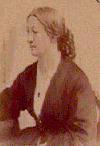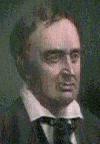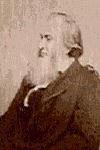
Gerrit Smith
- Biographical Information
There are three full biographies of Gerrit Smith
published to date. There is also a brief self portrait, which appears to have
been drafted as a campaign biography during Smith's 1856 run for the Presidency.
There are also a number of books in which elements of Smith's story are told.
To facilitate inquiry into Gerrit Smith, this page provides links to
summaries of the biographies, and to other books that give significant attention
to Smith and related subjects. It also presents a brief Web version of Smith's
biography, illustrated with contemporary images, documents and portraits of the
major players in Smith's life. Users wishing to furnish copies or reviews of
other materials related to Gerrit Smith are invited to contact the
website editor.
Gerrit Smith was a widely known philanthropist and social reformer of the
mid-nineteenth century. He was born in Utica, NY, in 1797 and made his
home in nearby Peterboro until his death in 1874.

Smith's father, Peter Smith, was among the early white settlers of
Madison County. He originally moved to Utica to establish a land business after
some years of trading with the local native inhabitants. During his years as a
fur trader (and partner of John Jacob Astor) he learned the language of the
Oneida people and formed a close relationship with the Oneida Chief Skenandoah,
after whom he named his first son. Smith made use of this relationship in
negotiating a lease for a large tract of Oneida land. The lease was invalidated
by the State of New York, which subsequently purchased the land from the Oneida,
and re-sold most of it to Smith. The State's action has been ruled invalid, and
remains the the subject of an unsettled dispute with the Oneida people.
Traditionals among the Oneida opposed the original transaction, and attacked the
surveyors when they began laying out the plan for Peterboro.
 Peter
Smith grew wealthy as a land speculator, and attained local prominence as the
first judge in Madison County. Among the Oneida he was called 'Saw Mill', an
apparent reference to his strong and energetic character. Little has been
written about Peter Smith's wife, Elizabeth Livingston, (at right) save
that she was the daughter of Colonel James Livingston, who served in the
Revolutionary War. Elizabeth's sister, Mary Livingston and her husband, Daniel
Cady, were the parents of Gerrit Smith's first cousin, Elizabeth Cady
(Stanton). Peter
Smith grew wealthy as a land speculator, and attained local prominence as the
first judge in Madison County. Among the Oneida he was called 'Saw Mill', an
apparent reference to his strong and energetic character. Little has been
written about Peter Smith's wife, Elizabeth Livingston, (at right) save
that she was the daughter of Colonel James Livingston, who served in the
Revolutionary War. Elizabeth's sister, Mary Livingston and her husband, Daniel
Cady, were the parents of Gerrit Smith's first cousin, Elizabeth Cady
(Stanton).
The remoteness of Peter Smith's relationship with his own father, Garret
Smith, was reflected in a letter dated 1825, in which the older Smith inquired
if his son had a wife 'living or dead". It was on Garret Smith's farm
near Tappan, NY, that British Major John Andre (Benedict Arnold's contact) was
hanged as a spy.
After the death of his first wife, Peter Smith remarried (apparently not
very happily), and moved to Schenectady. There were no children from his
marriage to Sarah Pogson. Throughout his life he referred to himself as 'Peter
Smith of Peterboro' (which is located in the Town of Smithfield). The letter
informing Gerrit Smith of his father's death is in the collection of Smith
Family Papers in the NY Public Library.
Gerrit Smith had one sister, and two brothers who lived to adulthood. His
sister Cornelia Smith Cochrane (1825-1890) was the mother of General
John Cochrane, at whose home Smith died. His brother Adolphus Lent Smith
(1800-1844) appears to have suffered from a mental or developmental disorder,
and was reportedly unable to care for himself throughout his life. Virtually
nothing is written about him. Peter Skenandoah Smith (1795-1858), his
older brother, also suffered from mental disorders, apparently secondary to
alcoholism. Peter Sken (as he was called) was married twice, and had two sons
by his (first) marriage. He was a general in the State Militia, and for a time
managed his brother's business affairs in Oswego. There were two other siblings
who died young, one a brother named James.
As a young man Gerrit Smith worked alongside persons held in slavery on his
father's estate (slavery was abolished in New York State in 1827). He traced
his lifelong effort to better the condition of African Americans to his sympathy
with the miserable lives of those he met in his youth. He and his brother Peter
Sken were sent to an academy in Clinton, New York. The academy evolved into
Hamilton College, and Gerrit entered as a freshman in 1814. His brother
returned home.
During his college years Smith was reportedly quite gregarious, and made
references to smoking and drinking at school. He was also evidently quite fond
of playing cards. In the Letter of 1868 published in the Hamilton Alumni
Quarterly, Gerrit Smith wrote of his college experiences a half-century
before. He included stories of the College President, Dr. Azel Backus, and told
of the day "on this farm, and by Kirkland's grave that we (mostly College
students) buried Skenandoah, the great Oneida chief." Skenandoah's grave
now lies within the bounds of the campus, near that of the missionary whom
Skenandoah had accepted as his teacher (and after whom the surrounding Town of
Kirkland is named). 
His correspondence with his parents during his college years reflected a
strained relationship with his father, whom he considered stingy. Smith gave the
valedictory for his graduating class in 1818, and married the College
President's daughter, Wealtha Backus. Shortly thereafter his mother died, and
after seven months of marriage his wife, age 19, died of "dropsy of the
brain." A letter in the collection at Hamilton College transmits a deed
for property, apparently to a member of the faculty, as an expression of thanks
for care provided to Smith's wife during what he described as "her severe
and lingering illness."
Devastated by the loss of his own wife, Peter Smith turned over the family
land business to his son Gerrit, and placed half of his land in trust with his
brother-in-law, Daniel Cady. The terms of the transfer left Gerrit
responsible for the property, and for an equal division among Peter Smith's four
children of the net proceeds, after payment of debts and and deduction of income
for himself. At the age of 21, Gerrit Smith became one of the largest, if not
the largest, land owners in New York State. He spent most of the subsequent
forty years disposing of his vast properties.
Family Life
In 1822 Smith married Ann Carroll Fitzhugh, whose father was one of
the founders of the City of Rochester. She was called Nancy by family members.
Their marriage lasted till their deaths, which followed in rapid succession.
Gerrit Smith died on December 28, 1874. Ann Carroll Fitzhugh Smith died on March
6, 1875, which would have been Gerrit's 78th birthday.
Ann C. Smith bore eight children, a fact that has not been correctly
reported by any published source. The correct number was identified by
Peterboro Historian Donna Burdick, from tombstone rubbings that identified a
previously unreported set of twins who "died too young to have names in
this world." Only two of the Smith's children lived to adulthood, the
more prominent being their daughter, Elizabeth Smith
Miller. Of those who died in their youth, their son Fitzhugh was the
oldest when he died in 1836 at the age of 12.
Ann Smith's relationship with her husband appears to have been loving, and
their correspondence suggests her willingness to advocate on behalf of their
children. A letter in the NY State Archives in Albany urges Gerrit's tolerance
of their son Greene, whom she reported struggling through a serious case of
withdrawal in his attempt at abstinence from cigars.
Smith's love of his son, evident in his laboriously printed letters to the
young Greene, was apparently tempered by his disapproval of Greene's later
alcohol and tobacco use. Apparently for this reason, he refused to attend his
son's wedding. Greene later served in the Civil War, and was apparently wounded
in battle. A post-war letter from General Burnside to Gerrit Smith expresses
his admiration for the son, and hopes for his recovery. 
Their daughter Elizabeth would likely have been favored child. As a girl
she wrote home during a visit to an aunt in Rochester that while baking she had
unthinkingly licked from her finger some sugar that had been produced with slave
labor. She reported that she promptly spat it out. As a woman, Elizabeth Smith
(Miller) was herself distinguished as a writer and advocate for women's rights.
Her papers are found in the collection at the NY Public Library.
Social Reform
Gerrit Smith's interest in social reform was wide ranging. He was a major
participant in various anti-slavery and
temperance societies. Disgusted with secularism and
the forgiving posture of contemporary churches toward slavery, Smith founded his
own church at Peterboro, where he professed what he called the Religion of
Reason.
He gave away an average of forty acres of Adirondack land in Northern New
York to each of more than 2000 poor (and "temperate") black men, to
permit them to meet the requirements for voting, and in hopes of promoting
self-sufficiency. He made similar gifts to poor whites, though for women he
decided the gifts impractical and substituted $50 in cash. He sold John
Brown and his family
land at North Elba, NY (near Lake Placid) where Brown
is buried. The plan was for Brown's family to help the new settlers to become
productive farmers. Though much of the land was clearly unsuitable for farming,
some lasting settlements were formed.

Smith was a candidate for President in 1848, 1856 and 1860. In 1852 his
nomination was considered by the Liberty Party, but he chose not to campaign.
Instead, he served in the Congress, representing Madison and Oswego counties
during 1853 and '54. He resigned at the close of his first session. A thank
you
letter to his constituents outlines his political
philosophy at the time of his election. In Congress he advocated an agenda
consistent with that described in his letter, and as noted in the draft of his
1856 campaign biography, his speeches there fill a book of nearly 400 pages.
His Final Letter to His Constituents provides a defense of his Congressional
service and illustrates the self-sustaining quality of Smith's reasoning.
Smith's close relationship with
Frederick Douglass
spanned many years. Smith helped to convert Douglass away from the 'moral
suasion' approach of the Garrisonians, and to a belief in political action. He
lent financial support to the publication of Frederick Douglass' Paper,
and persuaded Douglass of his strongly held view of the US Constitution as a
pro-liberty document, a view that also conflicted with that of the Garrisonians.
It is to this belief that Douglass refers in his dedication to Smith of his
second autobiography, My Bondage and My Freedom.
Douglass frequently traveled to Peterboro. Adaguerreotype
of an 1850 anti-slavery convention in Cazenovia, NY pictures the young Frederick
Douglass in front of the older Smith. The dramatic story behind this picture
has been extensively researched, and is described in a publication by the
Madison County (NY) Historical Society.
An even more dramatic story surrounds the arrest of a fugitive from slavery
in Missouri, called William "Jerry" Henry, and his subsequent
liberation from custody by an angry mob. The event was foretold in a speech in
Syracuse, and apparently set up, by then Secretary of State Daniel Webster.
The
Jerry Rescue is memorialized by a monument in Downtown
Syracuse.
A less well known story is that of Harriet Powell, who was liberated from
slavery during an 1839 visit to Syracuse. During the three weeks she stayed at
Smith's home, before making her way to Canada, Powell was introduced to Smith's
daughter Elizabeth Smith (Miller) and his young cousin,
Elizabeth Cady (Stanton).
It was in Peterboro that Cady met Henry Stanton, also a leading Abolitionist,
whom she married shortly thereafter. On her "honeymoon" at the World
Anti-Slavery Society meeting in London, Stanton met Lucretia Mott, with whom she
planned the first Women's Rights Convention, held eight years later in Seneca
Falls.
Smith was highly regarded by Stanton and others in the early years of the
women's rights movement, and was mentioned in
Stanton's address to the
Seneca Falls Convention. A letter expressing his support was read at the
opening of the August 1848 Convention in Rochester, immediately following Seneca
Falls. Though a strong public advocate of equality, Smith gave very little
money directly to the women's rights movement. He also exchanged public
correspondence with his cousin and with Susan B. Anthony that was
critical of the movement's leadership. Though this is not addressed directly
in their correspondence, Smith held very conservative views on the subject of
marriage (he opposed divorce under any conditions) that strongly diverged from
those of Stanton, and other radicals in the women's rights movement.
Smith's strong advocacy for women's dress reform was likely related to his
daughter's innovation in that area. An active supporter of women's rights,
Elizabeth Smith Miller is probably best known for the development of the costume
popularized by
Amelia Bloomer. Miller's
husband Charles Dudley Miller worked with Smith in his land office in
Peterboro, and also helped in the destruction of records after John Brown's
capture at Harper's Ferry. Their son, Gerrit Smith Miller placed the papers of
Peter and Gerrit Smith in the care of Syracuse University in 1928, twelve years
before the family mansion and its contents were destroyed in a fire.
Smith was a financial supporter of John Brown's military activity in Kansas,
and was implicated in his raid on
Harper's Ferry. He denied that he knew
of Brown's plan to raid the federal arsenal, believing he intended to create a
haven for fugitive slaves, to arm for self defense those who would escape, and
thereby inspire others to do so. Though Smith and several of Brown's other
co-conspirators (The Secret Six) reportedly avoided
knowledge of the specifics, there is little doubt that he was generally aware
of, and helped to finance, Brown's plans for anti-slavery action in Virginia.
The Harper's Ferry
raid, and its aftermath, make up an important part of
Smith' life story.

Having played a significant role in starting the Civil War, Smith was a
strong advocate and fundraiser for Union causes. After the war was over, he
called for reconciliation, and was one of three prominent Americans who, along
with ten Richmond business owners, signed the bail bond for Jefferson Davis.
Following the War, Smith remained active in reform efforts. He split with
Stanton and Anthony over the precedence he believed should be given to black
suffrage over that for women, siding with their rival, the American Woman
Suffrage Association. Stanton's subsequent characterization of her cousin in
letters to Anthony was quite bitter. He nonetheless continued his advocacy for
women, publishing his supportive letters to Anthony after her arrest in 1872 for
the crime of illegal voting.
Smith remained a staunch advocate of Temperance, and in 1869 published his
address to a Temperance convention in Chicago as well as a letter to John
Stuart Mill, who unlike Smith, was not supportive of Prohibition.
Gerrit Smith died on December 28, 1874 at the home of his nephew, Gen. John
Cochrane. Among the many printed memorials was a lengthy article published by
Henry Wilson, then Vice-President of the United States, titled: The Dying
Legacy of Gerrit Smith to His Countrymen. The article commended to readers
the last of Smith's printed circulars, written just two weeks before his voice
was silenced. Its title was Will the American People Never Cease to
Oppress and Torture the Helpless poor?
A letter from Frederick Douglass, Jr., thanking Smith for writing the
piece, is part of the collection at Syracuse University. The letter was written
Christmas Day, 1874, the day before Smith's death.

|
